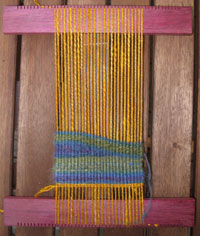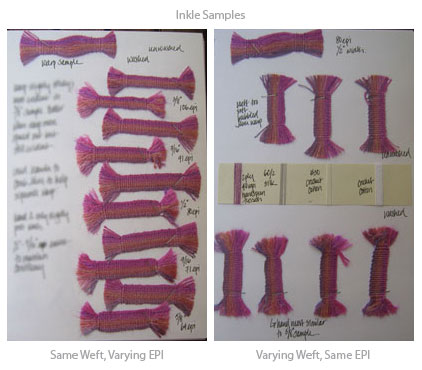I haven’t been spinning nor weaving much lately. I’ve been bitten by the weaving bug in the past week. Actually, it’s been going on for a while, but more from the perspective of experimentation than production.

Remember how I mentioned in my original Spring Cleaning post that I had an idea for an unspun silk project? This is what I wanted to play with. I wanted to see how unspun silk would work woven. I don’t think it will work with plain weave, but a weft face weave? It’s got possibilities.
But plain weft weave got boring very quickly. A bit more free-form weaving to concentrate a color kicks it up a notch. What you can’t tell here is that by drafting out the silk hankies into different thickness will change the texture of the woven piece. For example, if you don’t draft out the blue/purple section as much, that area of the woven piece will be thicker. Therefore, it will sit higher than the surrounding weaving.
I know. It’s obvious when you state it like this, but it was a bit of an “a-ha!” moment while playing with this. You can create textural interest within a single hankie by changing how you draft the hankie. Leaving some slubs in? Even more excitement.
However, it’s still a bit flat, and not very interesting as a whole piece. I think what I need to do is to use the unspun silk within a larger piece of tapestry. The unspun silk then becomes accent (or even background to highlight another yearn). The effect is flat and fuzzy. Yet another tool for the tool box.

I’ve also been playing with my inkle loom and some handspun. I had been struggling with with edges. I played a bit with different widths. Not happy with it, so I asked John for some guidance. We discussed the use of handspun vs commercial yarns for weft and how to vary the hand of the ribbons.
During our email discussion, I came across the article by Gwen Powell on an inkle woven purse in the Summer Spin-Off. Gwen’s ribbons were woven at approximately 2x the WPI as her EPI. What I was weaving was much sleazier than that. So I played with different EPIs and the effect on the ribbon.
What I found is that the higher the EPI, the easier it was to keep an even edge. But, I didn’t much like the fabric because it was so stiff. Of course, it could have been due to practice, practice, practice. By the time I finished these samples, I was getting fairly good at creating an even edge.
Then I tried using different weft: different sizes of crochet cotton, commercial silk. Using crochet cotton definitely changed the hand of the fabric. Using a finer weft yarn than the warp created a more supple ribbon.
John also mentioned that after washing, the hand of the ribbon will change. Gwen mentioned keeping a notebook of all her samples.
So, there you have it. The above photos show the first few pages of my inkle sample notebook. As John said in his email, until the computer offers a tactile option, there is a place for a physical notebook. I have 2 of each sample: before washing (just pressed) vs. after washing and pressing. Top of each page is also a sample of the unwoven weft, anchored at each end with a bit of weaving.
Just in case you are interested, the silk is spindle spun. 40 wpi. 5,050 ypp.
Did I mention that I have anal retentive tendencies?

John
Wow, you really went to town with this little experiment! You can have a lot of fun with wefts of varying thicknesses with Inkle Weaving. From sewing thread up to rope-like yarn (starts to look like Repp).
Camille N
Hi A –
Your unspun silk project looks like the beginning of a wonderful island sunset……
Camille